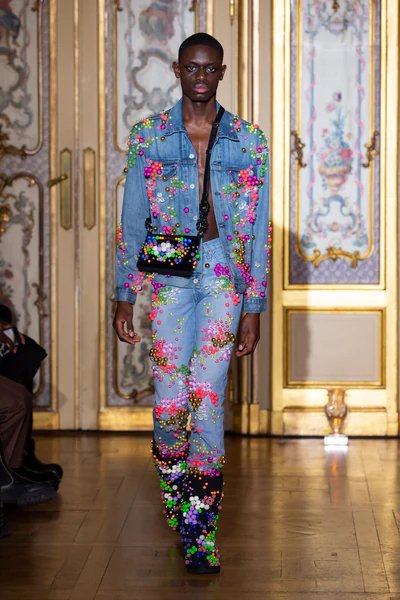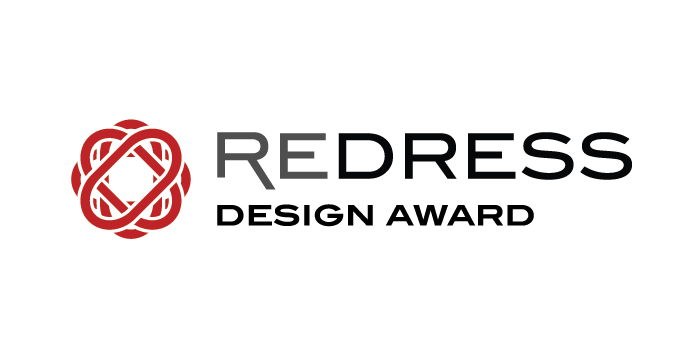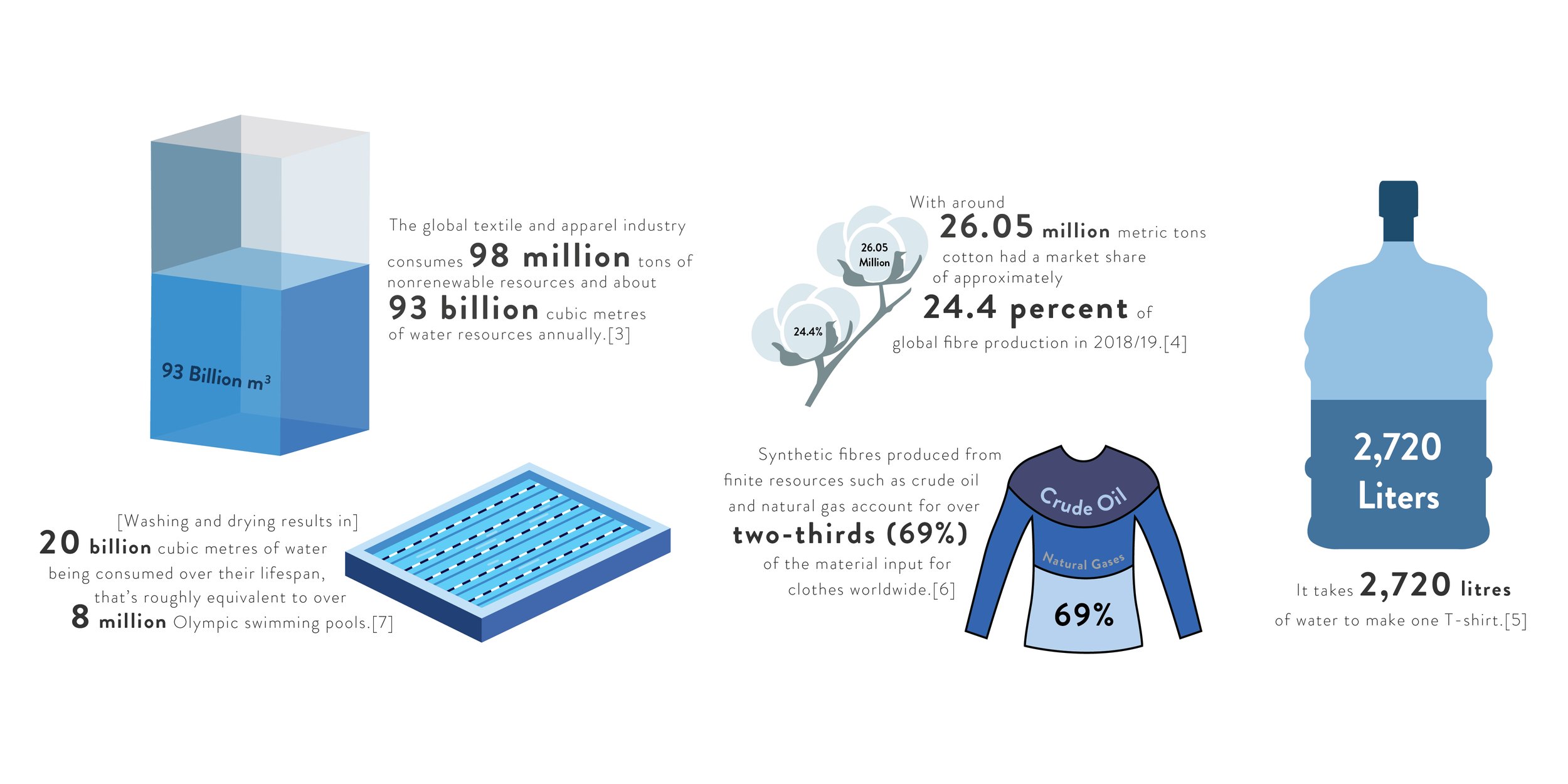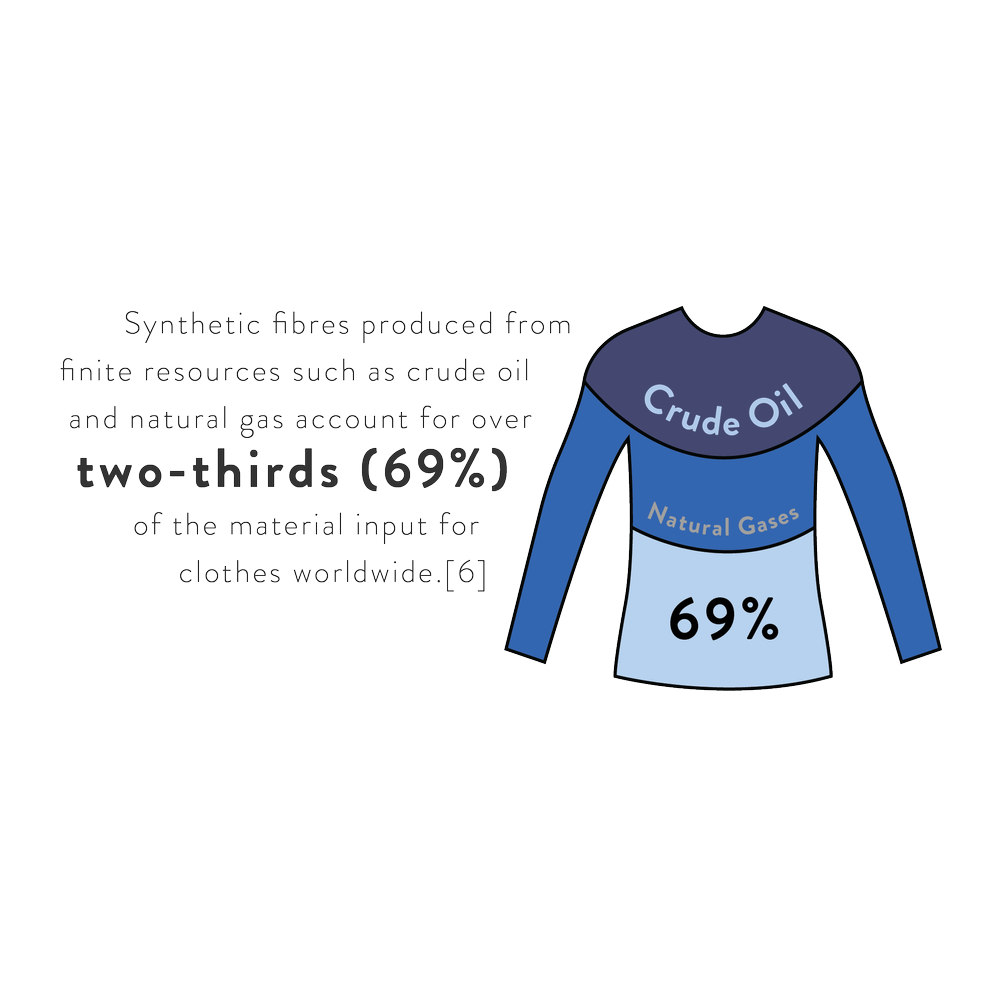Fashion & Environment Guide
Fashion & Environment Guide
Created by Redress
The issues at a glance
The fashion industry is much loved for its flair and cultural power for reflecting world affairs through the changing of trends and clothing. At the same time, it is also one of the world’s most environmentally polluting industries — and this cannot go on.
Fast fashion — the model of making clothes faster, cheaper, and generally of poorer quality for mass consumption — has accelerated the industry’s negative impacts. While fast fashion does allow for more people to enjoy changing trends at lower consumer prices, it has also left behind a trail of destruction through its production and consumption cycles, including textile waste and heavy demand on the earth’s natural resources throughout the supply chain. Worse, alarming amounts of toxic substances are released into waterways, soil, and air during the production of clothing. And the environmental impacts don’t stop once the clothes are purchased: the negative thread continues with the consumer’s washing, drying, ironing, dry-cleaning, and finally discarding of clothing, particularly when not recycled.
But, despite all of these complex challenges, we believe in the positive power of fashion!
Deeper into the issues
Textile Waste
The fashion industry generates textile waste during production and consumer use, so much so that it is now a serious environmental concern. Fast and vast production has accelerated textile waste globally, with it flowing from factories and cascading from closets too often into landfill. Despite textiles being almost 100 percent reusable or recyclable, textile recovery rates for recycling remain relatively low.
Textile waste reduction is increasingly under scrutiny by governments, nonprofits, and the fashion private sector. From adapting operations to minimise wastage, to revaluing what was once considered waste into new viable resources and recovering fibres, the fashion industry is adapting to society’s needs and climate change.
Natural Resources
Chemicals and Pollution
Pollution occurs throughout the product lifecycle, from textile production to transportation, and even after reaching consumers, when clothes are washed and dry-cleaned. At these various stages, a wide range of toxic chemicals are released into sediment or aquatic life through water systems, which can pass up through the food chain and reach humans. [8] Such pollutants may also enter the atmosphere, infecting the air we breathe and contributing to climate change.
The power of design
Some of these challenges may seem huge - but they can be overcome. We believe that fashion can be more environmentally sustainable and that the people involved in the fashion supply chain can benefit fairly. But to create this positive effect, rethinking is vital on how fashion is being designed, sourced, produced, consumed and repurposed.
As fashion professionals, you are inspiring because you hold the power to reshape this industry. Designers and their teams are behind everything that gets made and the sustainability of a product is ultimately in their hands, with around 80% of a product’s environmental impact locked at the design stage [12].
Today’s global supply chains are complex, making it hard sometimes to understand the real environmental impact of products. Identifying each step of your value chain and its different stakeholders and being critical about all your company’s operations will enable you to not only address the sustainability issues you might face, but also be transparent about the impact of your designs.
It’s time to start asking…
- What natural resources are required to produce the textiles that I wish to use? Are the resources I am using contributing to regenerative agriculture or depleting finite resources? How can I make the most out of these resources in my collections/business?

Image credit: Good Days
Get inspired by Hong Kong activewear brand Good Days: they adopt recycled polyester from FENC® TopGreen® , which is made from post-consumer plastic bottles. They also use recycled nylon from ECONYL® ,which is made from post industrial waste such as discarded fishing nets and carpets.
- What design techniques can I adopt to minimise my negative environmental impacts?

Image credit: YEOHLEE
Get inspired by sustainable New York luxury brand YEOHLEE, who has applied the zero-waste pattern technique to several of her designs. She infuses this skill into both the ready-to-wear line as well as her custom designs.

Image credit: Kevin Germanier
Get inspired by our Redress Design Award alumnus Swiss-born Kevin Germanier whose 2022 debut at Paris Fashion Week featured his signature upcycled beading and crystals embellished on jeans and boots.

Image Credit: Momo Wang
Get inspired by emerging Chinese designer, Momo Wang who launched in 2012 her ‘Third Hand’ collection, in which she reconstructed unwanted clothes from her own wardrobe and salvaged textiles to reduce the need to use virgin textiles.
- What are the environmental impacts of my products (water, carbon, chemical footprints, and waste)? Are there more environmentally friendly alternatives available that I can use during textile production and manufacturing?

Image credit: ICICLE
Get inspired by mainland China brand ICICLE, which has branded its product as “Made in Earth''. To minimise the environmental impacts, they select high-quality natural materials (such as rain-treated linen) as well as natural treatments( Pu'er tea dyeing and grain dyeing).

Image credit: Levi’s
Get inspired by US brand Levi’s who launched in 2011 their Water<Less denim collection that reduces the amount of water used in garment finishing by up to 96 percent for certain products.
- Where are my designs made? Am I taking advantage of local capabilities? What are the environmental impacts of my choice of factory? Does the factory have any certifications, and is it operating according to industry best practices?


Image credit: Cosmos Studio
Get inspired by Hong Kong Brand Cosmos Studio, who is cautious about their materials, production process, partner factory and its employees. Their manufacturing partner is BSCI approved, which ensures their employees’ safety and fair treatment. They are cruelty-free. They also achieve the “0 wastewater” goal through technology.
- Does a lot of wastage arise from my development and production processes (from sampling to manufacturing and quality checking)? What happens to this waste? Can I reuse it?

Image credit: For Soul The Label
Get inspired by Bali-based brand For Soul the Label, who uses their offcuts from their main line to create scarves, headbands and scrunchies in an effort to minimise any unnecessary waste.
- How are my products packaged? How are my orders being shipped? Are there lower-impact options available?

Image credit: Invisible Company
Get inspired by Hong Kong-based Invisible Company, which offers plastic-free, compostable and biodegradable packaging solutions.
- How do my customers care for their clothes? How can my customers extend the active life of my designs once in their wardrobe and make sure they never end up in landfill?

Image credit: Nudie Jeans
Get inspired by Swedish denim brand Nudie Jeans, who insert a consumer guide about better washing and consumer use into the back pocket of every pair of jeans they sell. They also offer a free repair service, give away free repair kits for customers who want to DIY their jeans and offer a second-hand platform. All of this aims to prolong their product’s life and reduce waste and the demand for virgin resources.

Image credit: Tove&Libra
Get inspired by Hong Kong womenswear brand Tove&Libra, whose labels provide detailed care instructions as well as handy tips to help customers extend the life of their clothing.
Footnotes
[1] Ellen MacArthur Foundation (2017), A New Textiles Economy: Redesigning Fashion’s Future
[2] Redress (2021), why should we get RedRessed?, https://www.redress.com.hk/geteducated
[3] China National Resources Recycling Association. 2019 China Recycling Resource Recovery Industry Development Report. https://www.switch-asia.eu/site/assets/files/2628/make_fashion_circular-outlook_for_a_new_textiles_economy-_-20201201.pdf
[4] Textile Exchange (2019), Preferred Fiber & Materials Market Report 2019
[5] Fashion Revolution (2020), Water Ways www.fashionrevolution.org/water-ways (Original source: Chapagain, A., Hoekstra, A., Savenije, H. and Gautam, R. (2006), The water footprint of cotton consumption: An assessment of the impact of worldwide consumption of cotton products on the water resources in the cotton producing countries)
[6] Changing Markets Foundation 2021 Fossil Fashion 2021 http://changingmarkets.org/wp-content/uploads/2021/01/FOSSIL-FASHION_Web-compressed.pdf
[7] Baillie Gifford (2019) Fast Fashion – Time to Kick the Habit?
[8] Toxic Threads Greenpeace, 2012
[9] Global Fashion Agenda (2020), GEO Agenda, Accesible at: https://www2.globalfashionagenda.com/ceo-agenda-2020/#climateChange
[10] UNFCCC (2018), UN Helps Fashion Industry Shift to Low Carbon
[11] Ellen Macarthur Foundation (2017), A New Textiles Economy: Redesigning Fashion's Future
[12] WRAP (n.d.), WRAP and the circular economy










































